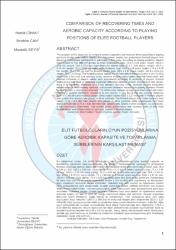| dc.contributor.author | Cihan, Hamit | |
| dc.contributor.author | Can, İbrahim | |
| dc.contributor.author | Seyis, Mustafa | |
| dc.date.accessioned | 2014-09-15T05:31:36Z | |
| dc.date.available | 2014-09-15T05:31:36Z | |
| dc.date.issued | 2012 | |
| dc.identifier.citation | Nigde University Journal of Physical Education And Sport Sciences | en_US |
| dc.identifier.issn | 1307-6477 | |
| dc.identifier.uri | https://app.trdizin.gov.tr/makale/TVRNeE9EZzJOZz09 | |
| dc.description.abstract | Bu çalışmanın amacı, elit erkek futbolcuların oyun pozisyonlarına göre aerobik kapasite ve toparlanma sürelerinin karşılaştırılmasıdır. Bu amaçla, Trabzonspor’da oynayan 24 profesyonel futbolcu çalışmaya gönüllü olarak katılmıştır. Oyun pozisyonlarına göre oyuncular; 3 kaleci (yaş: 26,0 ± 2,64 yıl; boy: 188,8 ± 2,88 cm; vücut ağırlığı: 79,6 ± 5,13 kg), 8 defans oyuncusu (yaş: 27,1 ± 2,69 yıl; boy: 183,5 ± 5,12 cm; vücut ağırlığı: 76,3 ± 3,06 kg), 8 orta saha oyuncusu (yaş: 25,8 ± 1,64 yıl; boy: 178,5 ± 8,79 cm; vücut ağırlığı: 75 ± 7,63 kg) ve 5 hücum oyuncusu (yaş: 28,0 ± 1,87 yıl; boy: 181,8 ± 4,81 cm; vücut ağırlığı: 73,4 ± 3,78 kg) olmak üzere dört farklı gruba ayrılmıştır. Futbolculara bir saha testi olan Yo-Yo aralıklı toparlanma seviye 1 (Yo-Yo IR1) testi uygulanmış ve futbolcuların koşu mesafeleri, maksimal oksijen tüketimleri, maksimal kalp atım sayıları ve toparlanma süreleri oyun pozisyonlarına göre incelenmiştir. Gruplar arasındaki anlamlı farklılığı belirlemek için Kruskal Wallis-H testi kullanılmıştır. Test sonuçlarına göre; erkek futbolcuların oyun pozisyonlarına göre koşu mesafeleri, maksimal oksijen tüketim değerleri, maksimal kalp atım sayıları ve toparlanma süreleri arasında anlamlı bir farklılık (p<0,05) olduğu istatistiksel olarak elde edilmiştir. Gruplar arasındaki farklılıklar Mann Whitney-U analiz tekniği ile belirlenmiştir. Test sonuçlarına göre; orta saha oyuncuların koşu mesafesi (1987,5 ± 260,3m) ve maksimal oksijen alımı değerlerinin (53,0 ± 2,17 ml/kg/dk) diğer oyun pozisyonlarındaki oyunculardan daha yüksek olarak bulunmuştur. Kaleciler, diğer oyun pozisyonlarında oynayan oyunculardan daha düşük maksimal kalp atım değerlerine (179,3 ± 8,50 atım/dk) sahipken, hücum oyuncuları ise diğer pozisyonlarda oynayan oyunculardan daha iyi toparlanma süresi değerlerine (3,38 ± 0,6 dk) sahiptir. Sonuç olarak, elit seviyedeki erkek futbolcuların aerobik güç performansları ve toparlanma sürelerinin futboldaki oyun pozisyonlarına göre farklılaştığı istatistiksel olarak elde edilmiştir. | en_US |
| dc.description.abstract | The purpose of this study was to compare aerobic capasities and recovery times according to playing positions of elite male football players. For this reason, twenty-four professional football players who played in Trabzonspor participated in voluntarily to this study. According to playing positions, players were divided to four different groups as three goalkeepers (age: 26,0 ± 2,64 years; height: 188,8 ± 2,88 cm; weight: 79,6 ± 5,13 kg), eight defencive players (age: 27,1 ± 2,69 years; height: 183,5 ± 5,12 cm; weight: 76,3 ± 3,06 kg), eight midfield players (age: 25,8 ± 1,64 years; height: 178,5 ± 8,79 cm; weight: 75 ± 7,63 kg) and five forward players (age: 28,0 ± 1,87 years; height: 181,8 ± 4,81 cm; weight: 73,4 ± 3,78 kg). The football players applied Yo-Yo Intermittent Recovery Level-1 (Yo-Yo IR1) which was a field test and recovery times, maximal oxygen consumption, maximal heart rates, and covered distances of players values were examinated according to positions of players. Kruskal Wallis-H test was used to determine significant difference between groups. According to test results, there is a significant difference (p < 0.05) between recovery times, maximal oxygen exhaustion values, maximal heart beating numbers, and covered distances according to playing positions of male football players is statistically obtained. The differences between groups was determined with Mann Whitney-U analyze technique. According to test results, it was found that the covered distances (1987,5 ± 260,3m) and maximal oxygen consumption values (53,0 ± 2,17 ml/kg/dk) of midfield players was greater than players who played in other positions. The forward players had better recovery time values (3,38 ± 0,6 dk) than players who played in other positions while goalkeepers had lower maximal heart rate (179,3 ± 8,50 atım/dk) than players who played in other positions. As conclusion, it was statistically determined that aerobic power performance and recovery times of elite male football player was differentiated according to position of football players. | en_US |
| dc.language.iso | eng | en_US |
| dc.relation.ispartof | Niğde Üniversitesi Beden Eğitimi ve Spor Bilimleri Dergisi | en_US |
| dc.rights | info:eu-repo/semantics/openAccess | en_US |
| dc.subject | Elite Football | en_US |
| dc.subject | Playing Position | en_US |
| dc.subject | Aerobic Power | en_US |
| dc.subject | Recovery | en_US |
| dc.title | Comparison of recovering times and aerobic capacity according to playing positions of elite football players | en_US |
| dc.title.alternative | Elit futbolcuların oyun pozisyonlarına göre aerobik kapasite ve toparlanma sürelerinin karşılaştırılması | en_US |
| dc.type | article | en_US |
| dc.relation.publicationcategory | Makale - Ulusal Hakemli Dergi - Kurum Öğretim Elemanı | en_US |
| dc.department | Gümüşhane Üniversitesi | en_US |
| dc.identifier.volume | 6 | en_US |
| dc.identifier.issue | 1 | en_US |
| dc.identifier.startpage | 1 | en_US |
| dc.contributor.institutionauthor | [Belirlenecek] | |
| dc.identifier.endpage | 8 | en_US |


















